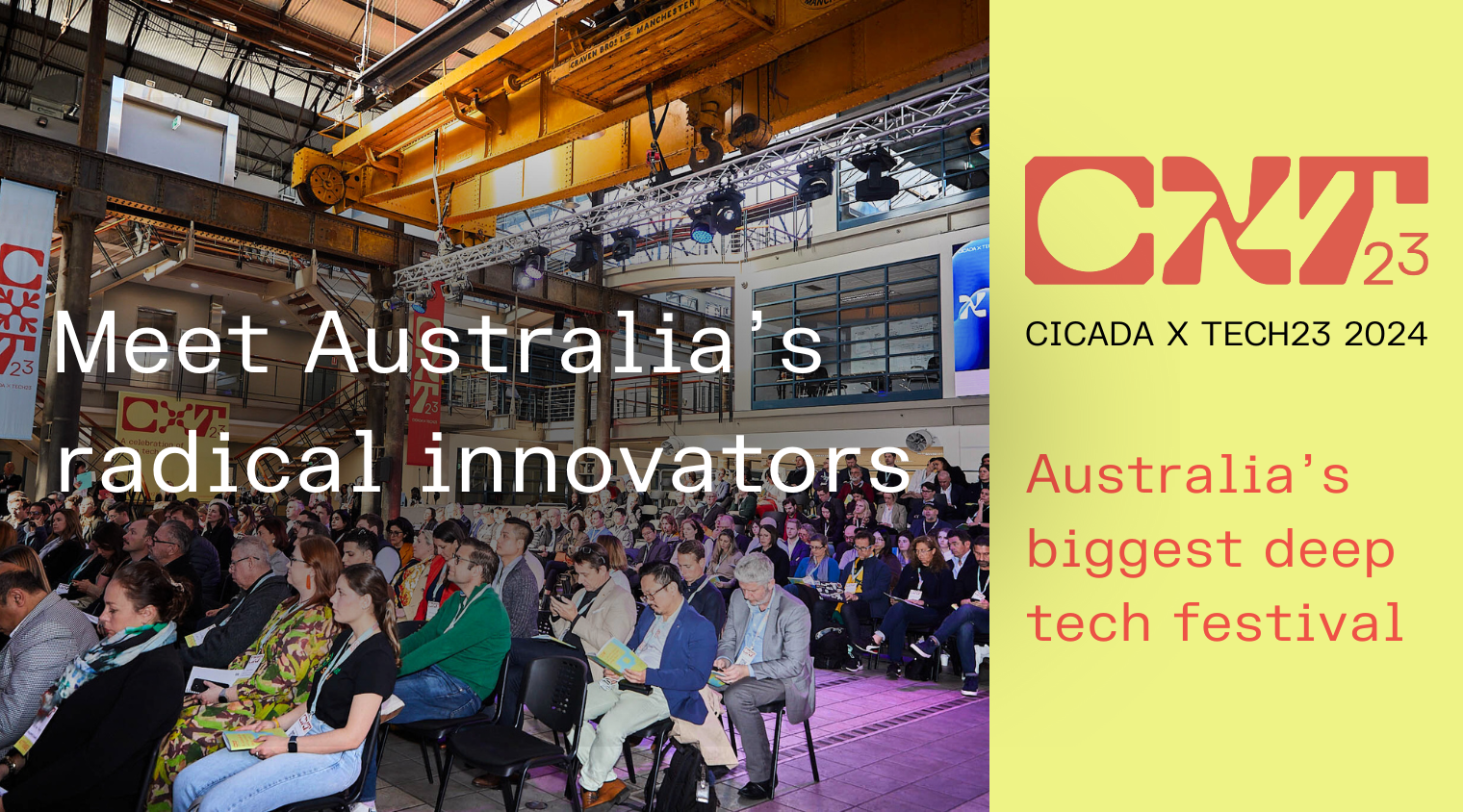From Microclimates on Skyscrapers to Water-Emitting Aircraft…Meet 23 deep tech ventures taking to the stage at Cicada x Tech23.

Australia’s biggest celebration of deep tech is back! Cicada x Tech23 is taking place in Sydney on 7th August, and will again spotlight 23 of the best of Australian deep ventures pushing the boundaries of science, innovation, and technology, and celebrate the people with the bold and big ambitions behind them.
The 23 ventures were selected from over 143 applications from across Australia, with an emphasis on diversity to ensure equality, breadth of innovations, and depth of perspectives.
This is not your traditional startup pitchfest, the 23 startups are organised into “systems”, themed streams that anticipate the future opportunities and challenges for Australia and the world.
We invite leaders from across the deep tech ecosystem and beyond to bring your unique perspectives and energy to help steer the conversations that could define the future of innovation in Australia. Get your ticket.
We are proud to introduce you to the class of ‘24.
1) Built Environment Reimagined
How can deep tech solutions transform urban environments into sustainable, interconnected ecosystems for all?
- Infrared, long-distance charging: Aquila is building an energy network of light that enables long distance, dynamic charging and energy transmission, able to keep a surveillance drone in the air 24/7, charge a commercial electric plane mid-flight, or relay a wireless power line between a solar farm and green steel manufacturer. This will help the 2 billion people worldwide experience energy poverty, increase EV charging speed, and address grid connection unreliability or accessibility.
- Microclimates for urban buildings: Eco Shield Systems grafts novel “green” ecosystems onto buildings using low-carbon porous facades, creating microclimates, preserving views, and improving maintenance access, reducing building heat load by 79%, and cutting carbon emissions by 40%. It was developed in response to the poor air quality, high carbon emissions, Urban Heat Island effect, and biodiversity loss afflicting our cities due to insufficient space for vegetation, impacting 30% of Australia’s threatened species and human health.
- Transforming vaccine delivery: Misti is developing a first-in-class advanced medication delivery platform for the delivery of therapeutic biomolecules to the lungs in a way that controls particle size, transforming how vaccines and therapies are delivered. This will help to address the acute respiratory infections (ARIs) responsible for 20% of all medical consultations and over 30% of lost work days, and the nearly 20% of mortality in children under 5 years attributed to ARI in developing countries.
- Halting morning commute disasters: Telemattica develops automated railway track inspections using IoT sensors fitted to in-service trains that enable continuous real-time data on the condition of train networks without impacting network capacity, and enabling new levels of efficiency, reliability, and safety. This will help to reduce the number of rail shutdowns that are currently required to conduct expensive and time-consuming checks of the network condition, and allow rail networks to better meet the constant pressure to run more trains.
2) Shifting the mindset of medicine
How can emerging deep tech innovations transform our understanding and practice of healthcare?

- Robot arthroscopy doctors: Convergence Medical is developing the world’s first arthroscopic robot to replace outdated and unreliable arthroscopy equipment. Equipped with up to 5 arms operating instruments, flexible miniature cameras offer safer operations and wider anatomy access, and US FDA breakthrough status (achieved by <3% of FDA submissions). Currently, arthroscopy requires a surgeon and 3-4 additional healthcare workers who use 5-8 separate devices and crude, rigid, and manually-controlled equipment offering only limited and basic functions.
- Slashing unnecessary biopsies: dermR Health aims to prevent 1 billion avoidable skin biopsies and save healthcare systems billions by tackling the global challenge of inefficient skin cancer diagnostics, where over 40% of biopsies are benign and could have been avoided. The DermR® Patch is a world-first microneedle device that painlessly collects skin cells for genomic analysis, can be performed by any genomics-enabled pathology provider, and screens across the spectrum of skin cancers including melanoma using just a few cells.
- Recreating tumours outside the body: OminiWell is aiming to deliver precise cancer treatment solutions through the development of BioTwin Chip; an in vitro cell culture device capable of cultivating patient tumour tissues outside the body. In 2022, there were ~20 million new cases of cancer and ~9.7 million deaths, with one in five people facing a cancer diagnosis in their lifetime. Fast treatment significantly enhances survival chances, however patient medication response variability prolongs the assessment of treatment effectiveness to 3 to 9 months.
- An oxygen tank in your pocket: Roam Technologies is developing an intelligent portable oxygen concentrator (iPOC) called JUNO that delivers over 1 litre of continuous oxygen flow (equivalent to industry-leading 5 litres-per-minute pulse-dose units), provides 90% medical-grade oxygen (+/- 3%), and is 50% smaller than comparable continuous flow devices. This will significantly improve the lives of those who rely on oxygen therapy.
- Smarter mRNA delivery: Tetratherix is developing the world's first smart Biostealth polymer technology, which can deliver treatments through the skin, blood vessels, or nose, forming a matrix that is invisible to the body and causes no foreign-body reactions. It has been commercialised for regenerative applications and is now being applied to mRNA delivery. Its mission is to extend and improve the lives of 10 million people around the world over the next 10 years by utilising Tetramatrix in multiple forms for a range of clinical applications.
3) Fortifying Industrial Futures:
How can emerging deep technologies create the blueprint of tomorrow’s industrial landscape?
- Space (and Earth) robots: Crest Robotics is on a mission to end workplace injury by developing smart robotic tools to protect workers - minimising risk and maximising the cost-effectiveness of labour. These robotic tools have applications across energy, construction, defence, space, and more.
- Autopilot for space: Deneb Space is advancing satellite agility by developing revolutionary systems that ensure mission success by leveraging aerospace expertise and a commitment to reliability and accessibility - making satellites smarter to navigate the congestion in space.
- Eliminating waste & supporting First Nations: Dilji Corporation is transforming waste into biochar (a form of charcoal) for underground mining paste fill, stabilising the earth, sequestering carbon, and supporting local Aboriginal communities. Its focus is on ethically-grounded technological and communication solutions for remote community, country & cultural outcomes.
- Halting drug smuggling & illegal fishing: Ocius Technologies is developing a solar, wind, and wave-powered unmanned surface vehicle (USV) called the Bluebottle, acting as a "sea satellite" to carry sensors to monitor remote areas for illegal fishing, drug smuggling, and other threats. A network of Bluebottles will enhance ocean research and security, protecting Australia's vast ocean borders (8 million km²) which are currently vulnerable with only 23 patrol vessels.
- Aircraft emitting only water: Stralis Aircraft is helping to enable aircraft fuelled by green liquid hydrogen produced from water using renewable energy, and which only emit water vapour from the tailpipe. The aim is for planes to fly 10 times further than battery electric alternatives at half the operating cost of fossil fuel-powered aircraft, potentially dramatically impacting the ~2% of global CO2 emissions caused by commercial air travel - a proportion that will increase significantly as other industries decarbonise.
4) Resilient Farming & Food Systems
How can deep tech innovations enhance the resilience and sustainability of our agricultural practices and food supply chains?

- NASA technology for cows: Agscent discovered that the technology from NASA sensors used on the International Space Station to alert crew to the detection of harmful chemicals, could also be used to detect pregnancy-related breath molecules in livestock. It is now developing livestock diagnostic testing that is non-invasive, efficient, accurate, and will allow point of care (POC) pregnancy and disease diagnostics which will improve livestock and dairy operator productivity, decrease costs, reduce operator injury and improve animal welfare.
- Animal-free “meat” fats: Nourish Ingredients is developing potent, animal-free fats that boost food performance and production with fewer or no animal ingredients, but which cook, smell, and taste just like the real thing by providing authentic animalic taste to plant proteins. With animal agriculture insufficient to meet future demand, this will help to protect the food supply for a growing population through assisting a shift towards a more plant-based diet and changes in how traditional food chains operate.
- Pioneering animal biotechnology: VetChip is developing a world-first implantable chip that provides real-time measurements of an animal’s temperature, heart rate, and respiratory rate then analyses them in the cloud to generate alert notifications if abnormalities are detected. This will change the way animal health is managed around the world, leading to earlier disease detection and improved veterinary care, better welfare, and happier, healthier animals - who cannot tell us when they are unwell.
- Maximising sustainable fashion: Zondii is supporting wool growers to remain sustainable by identifying the micron of the wool they grow in real-time through its machine learning-powered device that helps to produce a leading biodegradable textile. Consumers are increasingly looking for textiles that do not contribute to microplastic pollution in our oceans or on our land, and wool has long been accepted as environmentally positive, being 100% natural, renewable, biodegradable, and the most recycled apparel fibre in the world.
5) A Waste Free World
How can advancements in sustainable production and waste shift us to a circular economy?

- Saving our waterways: Adept Aqua is tackling the problem of depleted levels of dissolved oxygen which are threatening the health and survival of rivers and waterways globally. They use renewable energy to power an oxygen concentrator that oxygenates water, enabling wide deployment across river systems and reducing technical and commercial barriers. Their technology, previously used to treat children in developing countries, is now being commercialised to address this critical environmental issue.
- Plant-based leather: Alt Leather is creating a 100% biobased leather alternative using plant-based biopolymers. They turn agricultural biomass, fibres, and regenerative plant-based ingredients into a world-class material for application across fashion, footwear, furniture and automotive interiors. Fashion and textiles industries currently contribute over 10% of global emissions, and leather is one of the most destructive textiles on the planet contributing to deforestation, greenhouse gas emissions, toxic water wastage, and unethical treatment of animals and workers.
- Clean hydrogen extraction: EM Energy is pioneering a non-biological process to extract hydrogen from diverse agricultural waste sources that would otherwise contribute to landfill, burning, or decomposition, without needing heat or electricity and avoiding greenhouse gas emissions like carbon dioxide and methane. It is conducting trials on waste from the coal sector in the Hunter to demonstrate an ability to liberate hydrogen without combustion.
- Replacing fossil fuel dyes: Newera Bio takes inspiration from nature and marries it with their expertise in synthetic biology, to design a full spectrum of colour synthesis without compromising on dye performance while making dyes more sustainable.This will address the fact that over 95% of the fabrics we wear are coloured with fossil fuel dyes, generating 20% of the world's water pollution and contributing to 3% of global greenhouse gas emissions.
- Fertilisers using renewable energies: PlasmaLeap Technologies has developed zero-emission reactors using renewable electricity, air, and water. Starting with the ammonia fertilisers market, this innovation addresses the significant carbon footprint of traditional ammonia production, which accounts for about two percent of global emissions. Beyond ammonia, the technology holds potential for producing other green chemicals, offering sustainable alternatives and drastically reducing carbon emissions to a range of industries.


